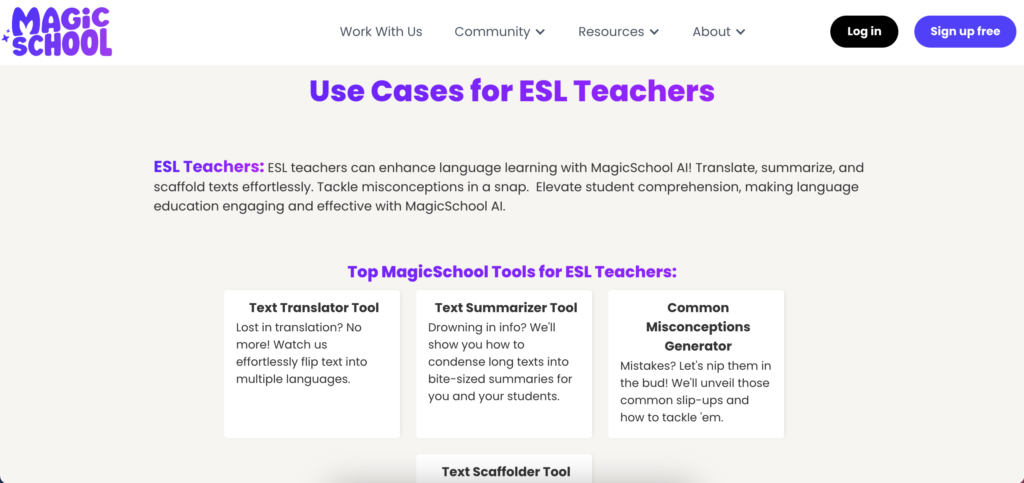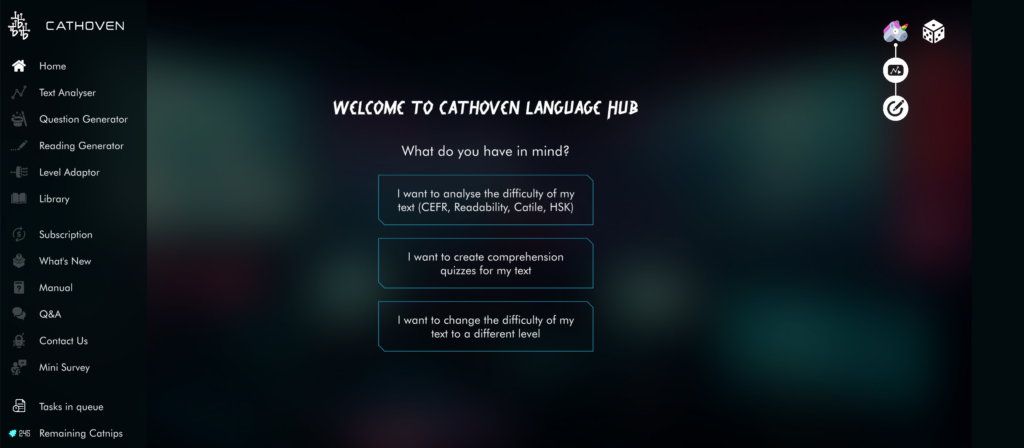AI and large language learning models (LLMs) are trailblazing in every industry, including English teaching. As a language enthusiast, you chose a career in education to inspire others. You chose teaching to teach, not for the endless preparation of comprehension quizzes, sourcing authentic materials and unpaid hours put in long, long after the school bell rings.
Good news: AI is here to rescue you from burnout. All that remains is to find the best AI tools to complement your needs and lend a helping hand. But with so many exciting choices on the market, how to decide?

What is Magic School?
Magic School knows the core of teaching is teacher-student interaction. Its mission is to stop teachers from being bogged down by tedious, repetitive tasks behind the scenes and to restore that connection. It caters to many school subjects, including English, science, mathematics and even sports.
What tools does Magic school have?
Magic School offers a selection of over sixty tools to experiment with. To keep users from scrolling and to make navigation easier, they have created webpages that group these tools by use case.
The ESL page boasts four tools, the first of which is the Text Translator Tool. It does exactly what it says on the tin: paste some text into a textbox and watch it translate a language of your choice in real time.
The Text Summariser Tool works the same way and condenses the information in a pasted text. Users can choose the number of paragraphs to control the level of detail and reading time. It also offers an extra classroom activity in the form of discussion questions.
The Common Misconceptions Generator can be used to explain complex grammar, language features or cultural topics that are commonly misunderstood. This could be useful for travelling students and help address a faux pax before it arises.
Perhaps the most useful tool is the Text Scaffolder. This sets a list of comprehension questions and words it should define for a text. These can be set by the user before the activity is generated. It can be made grade appropriate too, which is a nice touch.
There are a number of tools whose intended purpose isn’t ESL but might prove useful, such as the E-mail Family Tool, Lesson Plan Generator, and Informational Text Generator. Although some tools have an overlap in purpose, Magic School really has thought of everything.

How do you use Magic School?
With so many excellent tools to choose from, Magic School can be a little intimidating. Fortunately, grouping their tools by use case helps navigate the website. Once you have used a tool and generated materials, a textbox appears at the bottom of the webpage that allows you to take further actions or type prompts, akin to ChatGPT. This is useful if you want to create extra activities. However, you will have to return to the tool list to access some of the website’s features.

How much does Magic School cost?
Most but not all of Magic School’s tools are available for free. Magic School Plus costs $12.99 per month, but users can save 36% if they buy an annual membership for $99.96. Plus allows for more than one user per account and removes the cap on generation and analysis tools.
What is Cathoven?
Cathoven was designed by language teachers, linguists and AI engineers with one clear mission: to save ESL teachers from outdated tools, labour-intensive tasks and to bring the true power of modern AI into the language classroom.
What tool's does Cathoven Have?
Cathoven offers several tools focussed exclusively on ESL. The Text Analyser checks a text’s readability and difficulty. It achieves this using the Common European Framework of Reference for Languages (CEFR). But it does more than just offer a score. It also analyses tenses and sentence structure and splits each level into ten sublevels for increased accuracy, all of which can be observed onscreen. Once users know the reading level of their text, they can move onto the Level Adapter to update it to target any CEFR level needed.
The Reading Generator creates texts based on prompts, including CEFR level, length, genre and even grammatical structures users wish to include. Once that’s done, easily transition to the Question Generator to create quizzes for the text in either yes/no, multiple choice or short answer format.
In Addition to Cathoven’s strong basis in CEFR, it also offers tools that could be used for both non-native and native English speakers. The Writing Reviser checks the correctness of a text, giving users sentence-by-sentence feedback. It uniquely offers detailed suggestions and explanations for its decision-making. So, unlike some grammar checkers, you’re not left scratching your head and accepting changes based on faith.
Cathoven also has an in-house method for grading texts, Catile. This free, advanced measurement system could be used for assessing the level of assignments or homework returned by native or non-native students. It is a comparable alternative to the popular Lexile system. Catile grading usually corresponds to Lexile when measuring the same text.

How do you use Cathoven?
All of Cathoven’s tools are found in a central hub, allowing users to copy and paste texts across the different tools to accomplish various tasks without navigating through endless menus or returning to the landing page. A history of your work is kept for.

How much does Cathoven cost?
The free version of Cathoven limits the length of the materials its tools can generate and analyse. Using the tools costs the user Catnip, which is the AI’s currency. Those with a basic membership have six Catnip per day.
Cathoven Premium sets higher word limits on all its analysis and generation tools and gives the user 250 Catnips per month. This costs $11.59 monthly or $59.95 per six months. An annual membership costs $79.95 per year.
Magic School AI vs Cathoven AI - Summary
ESL Applicable Features |
Magic School |
Cathoven |
|---|---|---|
|
Precise level adapter |
✖
|
✔ |
|
Question generator |
✔ |
✔ |
|
Reading generator |
✔ |
✔ |
|
Writing reviser/checker |
✔ |
✔ |
|
Readability checker |
✖ |
✔ |
|
Video analyser |
✔ |
✔ |
|
Lesson planner |
✔ |
✖ |
|
Text analysis |
✖ |
✔ |
|
Precise toggle features with keywords |
✖ |
✔ |
Magic School’s packed toolbox covers many subjects and use cases, particularly focusing on schoolteachers in a classroom environment. The Text Leveler Tool, for example, is more focussed on school-age native speakers than non-natives.
That’s not to say that its tools not explicitly intended for ESL aren’t useful. While the Lesson Plan Generator and the Multiple Explanations for Complex Concepts tools might be general purpose, these welcome additions will certainly free up your time.
In contrast, Cathoven is developed by linguists focused squarely on language learning and the interaction of its ESL-optimised tools within a hub. It does so by maintaining the most comprehensive database on CEFR vocabulary globally, assigning difficulty to words not assigned levels in dictionaries. And unlike most assessment tools, it also factors grammar, sentence structure and phrases into its grading. This scoring system is evident across all tools.
In short, Magic School AI is great if you want a variety of tools to tackle the general pressures of modern teaching, especially if you are a subject teacher. Cathoven has honed its focus on the difficulties experienced by ESL teachers, listening to their pain points and sources of burnout.
Want to see if Cathoven can address your ESL preparation troubles? Get started with Cathoven’s AI tools free today.
